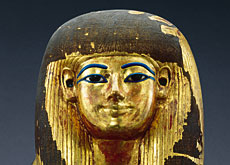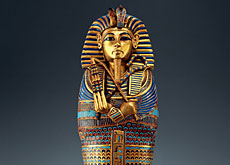Race on to save Egypt’s ancient treasures

Swiss archaeologists are joining the scramble to recover invaluable ancient remains in Egypt before they are lost forever beneath modern developments.
Cornelius von Pilgrim is leading efforts to unearth evidence of how people lived thousands of years ago near the southern city of Aswan.
“Many ancient towns are being covered by modern towns with deep foundations that destroy the ancient remains,” von Pilgrim told swissinfo.
The archaeologist from the Swiss Institute for Egyptian Architectural and Archaeological Research in Cairo has been working alongside Egyptian experts for the past six years in Aswan.
“We still do not know much about these old towns. They have been neglected because they are more difficult to dig and not as spectacular as tombs and pyramids,” he explained. “We know more about the beliefs of ancient Egyptians than about how they lived.”
Aswan is where they made the chance, but significant discovery of a stone ramp used to transport granite blocks to waiting ships.
They also found plenty of evidence of looting, an unwanted phenomenon that has dogged Egyptology for the last 200 years.
“Some of the sites were perforated like Swiss cheese with a maze of tunnels and shafts dug illegally to steal relics,” von Pilgrim said. “Once rumours get out that someone has found some beads then everyone starts digging. It is an enormous problem and very dangerous for the illegal diggers.”
Von Pilgrim has now set his sights firmly on unearthing new treasures under the soil in collaboration with Egyptian authorities with which the institute enjoys a “close and friendly” cooperation.
Little time
“But we do not have much time left,” he warned. “We also need to gain people’s trust because many landowners fear we will stop their construction and expropriate the land if we find remains, which is not the case.”
Von Pilgrim represents just one third of the institute’s permanent staff in Egypt. But this number is boosted to about 20 with archaeology students on temporary attachment from Switzerland and other parts of the world, plus local helpers who are educated in the ways of Egyptology by the staff.
“I am quite convinced that it is necessary to know about the past in order to move forwards. Everyone has to know about history to understand our modern culture,” von Pilgrim said.
“History also plays an important role in modern Egypt’s economy as tourism has an eminent value. Archaeological research is not just confined to pure science, but we also try to reconstruct sites for visitors to enjoy.”
Since 1969 the institute has been working alongside German colleagues on the Nile island of Elephantine. A garrison of foreign mercenaries had occupied the island, stationed there from around the seventh to the fourth centuries BC to protect Egypt’s southern border.
The digs uncovered remains of a Jewish temple and many other antiquities that greatly enhanced understanding about life in the garrison.
“I am convinced that we don’t know more than a fraction about the history of Egyptian society. The time is over when we wanted to discover new things all the time. We now need to fill in the gaps in our knowledge about normal life in ancient Egypt,” he said.
swissinfo, Matthew Allen
There is evidence of human habitation on Elephantine Island from as early as the fourth millennium BC. The garrison there moved to Aswan in the third or fourth centuries BC.
The current project there, which started in1969, followed up initial Swiss excavations in the 1930s and 1950s.
Unlike Aswan, the Elephantine site has no modern developments hindering archaeological research.
The Swiss Institute for Egyptian Architectural and Archaeological Research in Cairo started life as the Ludwig-Borchardt Institute, named after the German archaeologist who founded it as a private institution in 1931.
Berlin-born Borchardt (1863-1938) is credited with making a fundamental contribution to Egyptology and also founded the German Archaeological Institute in Cairo.
On Borchardt’s death it officially came under Swiss patronage to prevent it from falling into British hands during World War II. Since that time the institute’s headquarters have been based in canton Schaffhausen and has remained a privately funded organisation.

In compliance with the JTI standards
More: SWI swissinfo.ch certified by the Journalism Trust Initiative












You can find an overview of ongoing debates with our journalists here . Please join us!
If you want to start a conversation about a topic raised in this article or want to report factual errors, email us at english@swissinfo.ch.